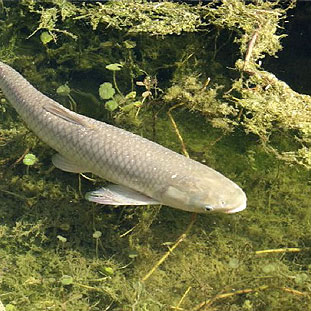Lake owners frequently ask if aeration will help their lake. Biologists agree that aeration helps keep a lake healthy. The benefits of aeration depend on the environmental factors that may influence the lake water quality. When natural mixing of lake water is not sufficient to maintain it in prime condition, aeration could be the answer. Aeration can improve the water quality, reduce algae problems, digest bottom organic muck, and increase fish production.
Many lakes, lagoons, and ponds do not have enough water circulation. Stagnant water zones form, resulting in low dissolved oxygen (DO) and become a sump for nutrients and organic materials. A buildup of these materials on the bottom speeds up the eutrophication process. As this process progresses, the problem of filamentous algae, planktonic blooms, turbidity, clarity, and occasional fish kills become a common occurrence.
Aeration slows down eutrophication by oxygenating the bottom waters and decomposing the organic materials that have settled to the bottom. As the organic materials and stagnant water are lifted to the surface and exposed to wind, sunlight, and atmospheric oxygen, there is further purification of the water. The aeration will slowly break up the stagnant zones, raise the DO, decompose the organic materials, and there is an improvement in water quality and fishing.
Aeration does not change the causes of eutrophication from nutrient inflow, storm-water runoff, organic accumulation, and siltation. It has been demonstrated that aeration can greatly slow down the eutrophication, improving water quality, fish production, and aesthetics. For this reason, aeration should be considered as part of the ongoing lake management program.
Future Horizons, Inc.’s biologists are often asked does our lake need aeration? The biologist can answer this question only by determining the lakes trophic state. They will measure the DO profile to determine if the lake is stratified, examine the bottom sediments, and try to locate the sources of inflow into the lake. These findings are then summarized in a written report (a fee will be charged for this work if Future Horizons, Inc. does not have a lake management contact with the lake owners).
Lake owners may be able to get a rough idea of the lake condition by checking the bottom. If there is an accumulation, of organic materials, or a black smelly ooze on the lake bottom, the lake is a good candidate for aeration. Lakes with a hydrosoil (a liquidy transitional layer between the true water column and the bottom) of several inches, are already experiencing degradation from poor water quality.
Should a lake owner determine that there is a need for aeration, the next question is what type of aeration equipment should be installed. There are three basic types of lake aerators: surface spray, horizontal aspirators, and air diffuser systems. Each type has its best use, and they may be used together to solve several types of problems.
Spray aerators provide the best vertical circulation in ponds less that 12-feet deep. They lift bottom water to the surface and spread it out over the surface waters to aerate it and create convection currents. The wave action caused by the spray pattern breaks up floating algae and discourages mosquito breeding. These aerators can also provide an attractive display.
Horizontal aspirators and mixers are ideal for lakes between 3 – 15 feet deep that will benefit from a strong directional flow. The units can be used to create artificial currents in long, narrow lakes or canals and will also break up floating algae and move stagnant waters. These units are a good choice where a visible spray pattern is not wanted. The design allows the installation of the units in very shallow water bodies.
Air diffusion systems are the most unobtrusive aerators. They are most effective in lakes with an average depth of twelve or more feet but can be installed into water as shallow as six feet. A shore-mounted air compressor pumps air through a supply hose to the diffuser located on the lake bottom. The diffuser emits the air in the form of bubbles that capture and entrain the bottom water and lift it to the surface. These systems have no surface visibility except the bubble boil. Air diffusion systems are economical to operate and are often used in conjunction with other systems.
When selecting an aerator, look for one that has a pumping rate of at least 400 g.p.m. and will produce 23 pounds of oxygen, per operating hour for each horsepower. A good spray or aspirating unit will provide this amount of oxygen but the air diffusion system will do more or less depending on water depth. During the selection process, make sure the aerator distributor has been properly trained in sizing, installation, and service. Thorough training is important to ensure the lake owner gets a product that is appropriate for the application.
Size and placement of the aerator system will determine the success of the unit. The following criteria can be used for various types: for surface spray and aspirating use 1.5 – 2 horsepower per surface water acre and for air diffusion use one diffuser per 1.5 surface acres in water twelve or more feet in depth. for lakes which have a round shape, place a spray or diffuser-type unit in the center and an aspirating unit near the shoreline to create a circular flow. Aerators or diffusers in long, thin or irregularly-shaped lake should be placed where they will create the most circulation.
The lake owner must realize that there is a difference between a fountain and an aerator. Fountains are designed to throw the water into the air and often into elaborate patterns. Pumping rates of fountains are usually designed to improve aesthetics and not water quality. There are aerators that can provide both water quality improvement and aesthetics. These units have higher pumping rates and are called aerator/fountains.
Future Horizons, Inc. is the distributor of several major manufacturers of spray, horizontal aspirators, mixers, diffusers, and aerator/fountains. The firm is also the servicing and warranty center for these manufacturers. The sales staff is experienced in lake management and water quality management. If you, as a lake owner, are considering aeration or fountains, please contact a Future Horizons, Inc. representative for information and assistance. The representative can also inform you of the other lake management services offered by Future Horizons, Inc.

